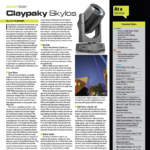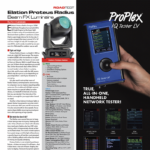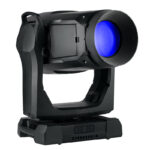The flagship of High End Systems’ latest series of Hog desks is the Hog 4. This beast of a desk weighs in at 75 pounds. A bit less, perhaps, than a full-grown sow (or a classic Harley). But it’s not something that you can easily stick into the back of your car. Consider this a team lift. Fortunately, the Hog 4’s road case features some nice wheels and handles easily.
If your team lift partner fails to show up on time, you might be able to maneuver the desk all on your own. But if that happens too many times, you might be tempted to emulate HES CTO Richard Belliveau’s “angry roadie” drop test — he did this, multiple times, in front of a camera. Take a look at www.plsn.me/Hog4Drop.
Even if the console has proven to stand up to that repeated abuse, however, it might be more strategic to show your team lift partner how to work the digital alarm on his or her iPhone so they can be a little more punctual next time.
What It Is
As might be expected with any console upgrade, High End Systems has included many of the features and functions of its earlier consoles in the latest incarnation. The Hog 4 is designed to keep users of previous HES consoles happy. And even though I never became one of the card-carriers and my familiarity with the Hog desks might not be as in-depth, I have used Hogs before, and I was able to start the desk up and get rockin’ and rolling in short order.
New on the Outside
In terms of hardware, the Hog 4’s layout is very similar to the Full Boar 3. Buttons and on-screen controls are still in the same general areas. The major difference is that the 10 faders are now motorized and fly on their own. A 7-inch touchscreen has been added between the faders, and there are new programming buttons along with the Kind/User keys on the right side of the control surface. The Hog 4 also offers a dedicated Grand Master fader, and that is motorized as well. So you will no longer have to sacrifice one of your 10 faders for a GM.
The two main 17-inch multi-touch displays are attached to the desk and are able to fold to any viewing angle. The screens lay down flat to fit into the road case — a nice feature that keeps the road cases compact for a tighter pack on the truck.
On the backside, under the grillwork, HES includes blue LEDs to light up the back of the desk. While a nice bling factor, I couldn’t decide if I loved or hated them. High End thought ahead and included not just the ability to dim the blue LEDs, but the under desk LEDs, the work lights and the brightness of each monitor. You can do this by holding down the Setup key and using the encoders.
The back panel includes all the standard connections you would come to expect for full-powered lighting desk. Since the Hog 4 has a DMX Processor 8000 built in, you have eight 5-pin XLR connections along with two Ethernet ports — one for Hog-Net, the other for Fixture-Net, (ArtNet or sACN). In total, the Hog 4 comes ready to handle 16 universes. More can be added as needed with processors and widgets.

 New on the Inside
New on the Inside
The full range of Hog 4 control products operates off a uniform operating system, so users won’t have to convert show files built on one of the systems before using it on another. Even the work you save using Hog 4 PC software can be used with any of the Hog 4 desks.
One of the major new Hog 4 tweaks involves the User Kinds controls on the right side of the desk. Through User Kinds, programmers can create custom encoder layouts. For example, I constantly use Pan, Tilt, Edge and Zoom parameters. Rather then having to constantly change the encoder types, I could create a new User Kind that populated the encoders with those parameters. Less paging and fewer button presses is always a good thing!
There are lots of other updates, including a new timecode toolbar, a unified fixture library, improved chases and a visualizer from LightConverse Ltd. This visualizer isn’t built in but comes with the desk — and could come in handy for pre-programming in a hotel room before load-in.
One new feature that I thought I would never comment on, since it has to deal with sound, is Open Sound Control. The Hog 4 can now send and receive messages via the Open Sound Control protocol over HogNet. What this mean is that you can build your own remote focus unit.
If you have a mobile device, like an iPad or Android, by using an OSC app you can now interface with the Hog 4. Say you want just a bank of extra faders. You can build it, configure the notes to talk with the Hog 4 and voilà, you have a remote designed by and for you.
Although the Hog 4 currently does not have its own dedicated remote app, and the OSC solution may take some tinkering, the nice thing for me was that I know exactly what the remote can and cannot do, since I designed it.
Similar UI, New Features
If you know Hog, you know the Hog 4. Sure, there are new features, slight UI changes and, of course, the hardware is completely different. If you are, or were, a Hog Programmer Card Member, after less than 10 minutes in front of the new desk, you’ll be right back in action. For programmers who have never used a Hog before, of course, there’s more of a learning curve, as with any unfamiliar console. With some proper training up front and some good old-fashioned time on the desk, you’ll be on your way to your Hog Membership card in no time… that is, if there still is such a thing!
Hog 4 Specs
- Size: 40.5” x 16.4” x 28.5”
- Weight: 75 lbs.
- Compliances: ETL, CETL, CE
- USB Ports: 2 front, 6 Rear
- External Display Ports: 3 DVI
- DMX Ports: 8 5-pin
- Ethernet: 2 Ports
Hog 4 Features
- Built in Keyboard with Drawer
- Solid State Hard Drive
- Internal CD/DVD Drive
- External eSATA Port
Other Hog 4 Control Options
- Hog 4
- Full Boar 4
- Road Hog 4
- Nano Hog 4
Retail Prices
- Hog 4: $44,000
- Full Boar 4: $28,500
- Road Hog 4: $10,500
- Nano Hog 4: $5,800



